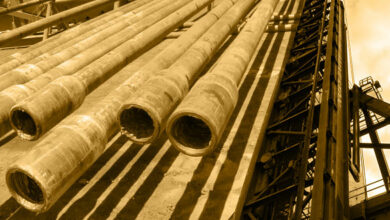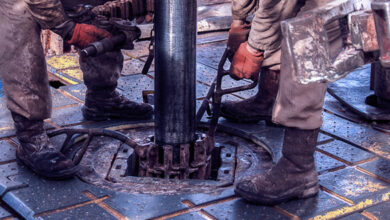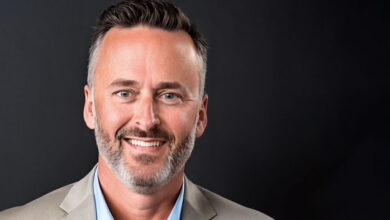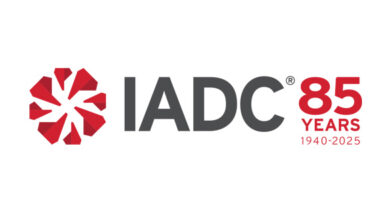2009 chairman profile: Maersk Drilling’s Claus Hemmingsen
By Linda Hsieh, assistant managing editor
In 1981, Claus V Hemmingsen, born and raised just outside of Copenhagen, was fresh out of high school and had no inkling what he wanted to do or where to begin his career. He certainly had no aspiration yet for the drilling industry, having had no prior exposure to the energy business.
In fact, he had no prior exposure to the shipping business either, yet decided to apply for the A.P. Moller Shipping Academy. As one of Denmark’s largest companies, A.P. Moller – Maersk Group was known for taking care of its employees and conducting business on a long-term vision. It also has multinational operations covering not only shipping but also oil and gas, retail and manufacturing. The fact that it offers employees a global education was another plus, Mr Hemmingsen said. “So I applied for that, and, against my expectations, I got it.”
By the time he completed the Shipping Academy’s training program two years later, he was convinced that A.P. Moller – Maersk “was the right place to work, and I definitely had a long-term career in mind already.”
However, when he actually started at the company, he didn’t go into shipping. Instead, he wound up at the company’s drilling business – Maersk Drilling – getting his first taste of offshore drilling rigs and operations. For six years, he stayed in the drilling contractor’s human resources department, working to make sure that its rig fleet was always sufficiently manned and that personnel were properly trained.
In the beginning, he found he had stepped into a world that was unfamiliar and vastly different from the shipping industry he learned about in the academy and from the general image of A.P. Moller – Maersk. Yet it didn’t take long before Mr Hemmingsen found himself completely immersed in the complexities and innovations of offshore drilling.
“I was really impressed with the industry and the people in it,” he recalled. “They were entrepreneurs and very innovative, always finding new resources and solutions offshore. You could say it was the people in the industry who really motivated me in those years.”
Back to shipping
However, no matter how innovative the industry was, it couldn’t innovate its way out of the 1980s oil bust. An extremely oversupplied rig market and low oil prices meant that contractors had an increasingly harder time finding work for their units. For Mr Hemmingsen, this also meant a harder time fulfilling his ambitions of working abroad. The closest he got, he recalled, was spending three months in Canada, manning an acquired semisubmersible, the Maersk Vinlander, for operations – but then the contract fell through and he was sent back to Denmark.
He realized that, with the drilling market in the condition it was, he would have to make a strategic career change. So, in 1989, he looked back to his Shipping Academy roots and decided to apply for a job with Maersk Line, which handles A.P. Moller’s container shipping activities. “I knew I wanted to do operations, and I wanted to do it in Asia, preferably Hong Kong,” he said. Hong Kong was the location of the company’s largest port operation in Asia, and “I knew it would be both an exciting and challenging place” to work and gain experience.
By 1992, he got his wish and, with his wife Susanne and baby son Mads, headed to Hong Kong as general manager of operations for Maersk Hong Kong. This marked both his first operational and commercial responsibilities and the beginning of a stay in Asia that would last nearly 12 years.
In 1997, he moved to Singapore to assume the overall regional responsibility in Asia for Maersk Line; then was promoted back to Hong Kong in 2000 to assume overall responsibility for A.P. Moller – Maersk’s activities there. In 2002, his areas of responsibility were expanded to include the southern China provinces. “Basically I rose through the ranks through hard work and motivation over those years,” he said.
Although the specifics of the shipping industry are completely different from drilling, Mr Hemmingsen noted that many of the broader challenges are the same, and he believes his shipping experience has been invaluable to him even in the drilling contractor business.
For example, his time in Asia marked a period of significant growth, both organic and acquisitions, for the company’s shipping line. It also required working with people of different cultures – i.e., how to make a Western management culture work with local Asian employees. The drilling industry is going through some of the same issues now – it’s feeling its way through a huge fleet renewal, and multinational crews are fast becoming the norm on rigs everywhere. These are challenging issues for industry leaders, he said, and he is happy to be able to carry those leadership lessons from shipping over to his drilling career.
Another lesson he has taken over to the drilling business is “client focus.” “Shipping is a very transactional business. It’s really about customer service and supplying logistics solutions. For me, moving from the operational side and going towards the customer side helped me to focus on what the customer really needs and understanding what our value proposition is, instead of just executing the business according to your own ideas.”
Then, back to drilling
In 2003, it was time to get back to the company’s Copenhagen headquarters. A reorganization of the Maersk Line business opened a new opportunity, and soon Mr Hemmingsen was promoted to senior vice president and moved back to Denmark to start a new project called Global Shared Service Centres and to assume responsibility for APM Terminals.
It took him a year to consolidate APM Terminals and move its headquarters to The Hague, The Netherlands. After that, he concentrated on developing Global Service Delivery and Global Shared Service Centres for Maersk Sealand and Maersk Logistics.
“Then it was back to where I started, you could say, in January 2005,” he said, when he was appointed as CEO of Maersk Contractors (now Maersk Drilling).
“I was very enthusiastic about that because I saw opportunities. Contractors had not really been developing as fast as the (energy) industry in general, so there was room for us to create a strategy and grow this company,” he said.
Mr Hemmingsen’s appointment came in January, and by March that same year, Maersk had placed an order for four identical high-efficiency jackups from KeppelFELS in Singapore. By May, it had ordered two more rigs – deepwater semisubmersibles that could drill in up to 10,000 ft of water. In 2006, an option was declared for a third deepwater semi, and the acquisition of Petrojack added two more jackups to the fleet.
“To the credit of the people who were here when I joined, they had been working on these projects for years. What we did was create a new strategy and a solid foundation. Soon after, we got the approval from the board to follow the strategy, then approval for the projects. That was the given task and purpose, so I was happy to see it go through,” he said.
Fleet build-up
The newbuild rigs each play into one of three growth areas that Mr Hemmingsen had helped to define for Maersk Drilling – harsh environment, deepwater, and high-efficiency jackups.
The first focus area, harsh environment, is one that Maersk knows well from its history in the North Sea. The fleet presently includes six harsh-environment jackups, five of which are working in the Norwegian sector of the North Sea.
On the deepwater front, the Maersk Developer, the first of the three deepwater semis to be delivered, is already headed to the Gulf of Mexico on a four-year contract to Statoil Gulf of Mexico. The other two semis are expected to be delivered in 2009 and 2010 – one will go to Australia for Woodside Energy while the third may head to Angola.
“We have a rather positive view on the deepwater activity in the US GOM. From the latest lease sales in the US GOM, we have seen a strong interest in deepwater acreage from oil companies, which is an early indicator of deepwater activity and hence demand for deepwater drilling capacity. If opportunity arises, we will consider further investments in deepwater semisubmersibles,” Mr Hemmingsen said.
In addition to sophisticated semis, the high-efficiency jackups were also designed to fit into Maersk’s focus on having highly capable rigs.
“The high-efficiency jackups came about because operators were asking for modern rigs with good capacities. Since the introduction of our Maersk Innovator- and Maersk Inspirer-type jackup rigs in 2003, operators realized that improved drilling efficiency can be achieved, and they are increasingly asking for efficiency.”
The four new jackups, which can work in water depths up to 350 ft (107 m) are expected to increase drilling performance by 20% compared with conventional jackups, although he noted that the Innovator and Inspirer, two of the largest jackups in the world, have been able to surpass the original 20% estimate. “We wanted to take that experience and apply it to smaller rigs as well. Also, we wanted to build for the future and for our newbuild rigs to differentiate themselves from the competition.”
Two of the four high-efficiency units have been delivered so far. The Maersk Resilient is offshore Dubai working for Dubai Petroleum Establishment, and the Maersk Resolute is on its way to the Danish part of the North Sea for Dong Energy.
Mr Hemmingsen said it’s possible that one or both of the remaining two jackups could end up in the North Sea, though the company is considering other areas as well. “We would like to place these rigs somewhere where we can obtain a return that justifies the extra investment we have made by introducing the various performance-enhancing features.”
The two new high-spec 375-ft jackups, Maersk Completer and Maersk Convincer, have been working in Brunei since delivery in 2007 and 2008.
Although Maersk is clearly growing and intends to expand even more, Mr Hemmingsen noted that it is not after size. “We are not going to grow in size just to be big. We want to grow with the right equipment. We are introducing state-of-the-art rigs with features that promote better health and safety for our employees. They have mechanized equipment and handling that facilitate both drilling efficiency and safety. The crews have some of the best living quarters that exist offshore. Our vision and what we are striving for at Maersk Drilling is to keep growing in that segment.”
Industry outlook
Looking industrywide, even though the underlying fundamentals of oil and gas still suggest a positive forecast, he said, we are now in a time of great uncertainty. With the global crisis spreading what was a strictly financial phenomenon to all economic sectors, oil prices have sharply declined. Hence, markets are jittery. In the medium term, however, Mr Hemmingsen expects the positive outlook for rig owners to prevail.
Still, challenges of a more fundamental and threatening nature hover nearby.
“First, costs have risen rapidly,” he said. As recently as September, we would have expected costs to continue rising. Now, that’s less certain in the short term.
However, escalating costs over the past four years have pushed up yard prices significantly. “The high building costs are most certainly putting a damper on contractors’ newbuild plans. Dayrates would need to beat new records in order for an investment to deliver a reasonable return. I expect the current situation to have an impact on prices from both yards and equipment suppliers, that ultimately will provide more balance to the overall cost picture ”
The silver lining is that costs haven’t had any negative effect on rig demand yet, he said. “There may of course be some programs that may be shelved either due to high costs or likely being down-prioritized due to tight availability. We do not know the projected oil price that the operators use for sanctioning drilling programs, but expect that the current level of oil prices still outweighs the rise in drilling costs.”
In fact, rather than cost, he pointed out, the real obstacle for drilling programs may be people. “Experienced staff is in high demand, and access to qualified and experienced personnel might limit the number of projects being executed. This is a huge issue for rig owners and oil companies alike ”
At Maersk, the recruitment process for new rigs began as soon as the decision was made to build them. “We also decided to broaden our search area to other parts of the world. It has so far proven to be the right decision, and we have recruited and employed people from all over the globe. Today we are a little ahead of the recruitment plan. However, as long as we add to the fleet and as long as the global rig market expands, it will remain a big challenge to identify and hire the right people.”
Dayrates, like rig demand, are expected to stay strong, especially in deepwater. Mr Hemmingsen pointed out that some rigs with near-term availability have been contracted recently at dayrates above $600,000.
“With very limited availability, we are rather positive on the future direction of deepwater drilling rates, and we believe that high dayrates for ultra-deepwater floaters will prevail.”
“At the same time,” he said, “the drilling industry is inherently a cyclical industry, so I am convinced that there will be a day when the supply and demand will be better balanced than it is now. Right now there is a shortage of rigs, and we will probably go into a more balanced situation sometime in the future.
“In the near- to medium-term future, I don’t think we will see an oversupply. The industry fleet is growing old fast. Combined with the increasing focus on environmental performance – everything from emissions to fuel consumption – and the need for better drilling efficiency, older rigs will be gradually phased out over the next five to 10 years.”
IADC 2009 chairmanship
Recalling his first encounter with IADC, Mr Hemmingsen said he came across the name as early as 1981, when Maersk Drilling HR was using IADC stationary. More substantial involvement began when he became CEO of Maersk Drilling. “Very quickly after I joined in 2005, I took an interest in IADC.”
He soon saw the important role the association played – for example, in ensuring global training standards and keeping companies abreast of regulatory issues. “IADC is not a body with executive power, but it can rally people around the industry on certain issues. The operations staff at IADC does a tremendous job in keeping everyone alert to changes from various authorities. I don’t think that IADC should necessarily take it upon themselves to bring solutions to everything, but it will raise everyone’s awareness and alertness.”
As 2009 chairman of the association, Mr Hemmingsen noted two issues he would like to focus on – raising the profile of the industry in the public domain and making sure it can attract the right people into the business. “We need to make the world aware of what we do, and I think the IADC plays a key role in that. We also must make sure the industry can employ and keep the right kind of personnel, because we are heading into a severe challenge in that area.”
He also firmly believes that IADC will take a more engaged approach to rising environmental performance requirements. “Seeing IADC rise to the same level of facilitation and development of members’ environmental performance as it has for many years been done on safety will be gratifying,” he said.
Finally, Mr Hemmingsen pointed to IADC’s 2006 chairman, Claus Chur of KCA DEUTAG, and said he would like to follow in Mr Chur’s footsteps to bring a more global perspective to the association. “I think the industry is very American-influenced; therefore it’s a very can-do industry. I’m very impressed with the way people attack problems and find solutions. But sometimes we also need to remember that this is a global industry, and I look forward to bringing that angle once more to IADC, to make sure that we serve our members in all ends of the world.”




